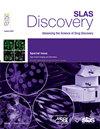Aurora 2.0:一个荧光染料库,用于扩展蛋白质自适应差示扫描荧光法(paDSF)的能力。
IF 2.7
4区 生物学
Q2 BIOCHEMICAL RESEARCH METHODS
引用次数: 0
摘要
差示扫描荧光法(DSF)是一种生物物理分析,用于估计蛋白质在体外的稳定性。在DSF实验中,溶剂化染色染料(如Sypro Orange)的荧光增强用于检测加热过程中蛋白质的展开。然而,Sypro Orange仅与少数蛋白质(< 30%)兼容,限制了该方法的适用范围。我们最近报道了蛋白质自适应DSF (paDSF)可以部分解决这个问题,其中蛋白质最初针对约300种化学不同的染料进行预筛选,称为Aurora收集。虽然这种方法显著提高了DSF可适应靶标的数量,但它仍然无法产生某些蛋白质的蛋白质-染料对。在这里,我们将染料收集扩展到Aurora 2.0,其中包括总共517个结构多样的分子和多个新的化学型。为了评估性能,这些染料针对一组约100种蛋白质进行筛选,这些蛋白质被选中部分代表最具挑战性的目标(例如小尺寸)。通过这一努力,Aurora 2.0取得了令人印象深刻的94%的成功率,包括为一些在原始收集中不匹配的目标生产染料。这些发现支持了这样一种观点,即更大、化学成分更多样化的文库提高了在更大范围的蛋白质中检测熔化转变的可能性。我们建议Aurora 2.0使paDSF成为高通量研究蛋白质稳定性,配体结合和其他生物物理性质的越来越强大的方法。本文章由计算机程序翻译,如有差异,请以英文原文为准。

Aurora 2.0: A fluorogenic dye library for expanding the capability of protein-adaptive differential scanning fluorimetry (paDSF)
Differential Scanning Fluorimetry (DSF) is a biophysical assay that is used to estimate protein stability in vitro. In a DSF experiment, the increased fluorescence of a solvatochromatic dye, such as Sypro Orange, is used to detect the unfolding of a protein during heating. However, Sypro Orange is only compatible with a minority of proteins (< 30 %), limiting the scope of this method. We recently reported that protein-adaptive DSF (paDSF) can partially solve this problem, wherein the protein is initially pre-screened against ∼300 chemically diverse dyes, termed the Aurora collection. While this approach significantly improves the number of targets amenable to DSF, it still fails to produce protein-dye pairs for some proteins. Here, we report the expansion of the dye collection to Aurora 2.0, which includes a total of 517 structurally diverse molecules and multiple new chemotypes. To assess performance, these dyes were screened against a panel of ∼100 proteins, which were selected, in part, to represent the most challenging targets (e.g. small size). From this effort, Aurora 2.0 achieved an impressive success rate of 94 %, including producing dyes for some targets that were not matched in the original collection. These findings support the idea that larger, more chemically diverse libraries improve the likelihood of detecting melting transitions across a wider range of proteins. We propose that Aurora 2.0 makes paDSF an increasingly powerful method for studying protein stability, ligand binding and other biophysical properties in high throughput.
求助全文
通过发布文献求助,成功后即可免费获取论文全文。
去求助
来源期刊

SLAS Discovery
Chemistry-Analytical Chemistry
CiteScore
7.00
自引率
3.20%
发文量
58
审稿时长
39 days
期刊介绍:
Advancing Life Sciences R&D: SLAS Discovery reports how scientists develop and utilize novel technologies and/or approaches to provide and characterize chemical and biological tools to understand and treat human disease.
SLAS Discovery is a peer-reviewed journal that publishes scientific reports that enable and improve target validation, evaluate current drug discovery technologies, provide novel research tools, and incorporate research approaches that enhance depth of knowledge and drug discovery success.
SLAS Discovery emphasizes scientific and technical advances in target identification/validation (including chemical probes, RNA silencing, gene editing technologies); biomarker discovery; assay development; virtual, medium- or high-throughput screening (biochemical and biological, biophysical, phenotypic, toxicological, ADME); lead generation/optimization; chemical biology; and informatics (data analysis, image analysis, statistics, bio- and chemo-informatics). Review articles on target biology, new paradigms in drug discovery and advances in drug discovery technologies.
SLAS Discovery is of particular interest to those involved in analytical chemistry, applied microbiology, automation, biochemistry, bioengineering, biomedical optics, biotechnology, bioinformatics, cell biology, DNA science and technology, genetics, information technology, medicinal chemistry, molecular biology, natural products chemistry, organic chemistry, pharmacology, spectroscopy, and toxicology.
SLAS Discovery is a member of the Committee on Publication Ethics (COPE) and was published previously (1996-2016) as the Journal of Biomolecular Screening (JBS).
 求助内容:
求助内容: 应助结果提醒方式:
应助结果提醒方式:


